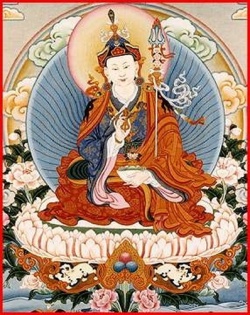Padmasambhava's Departure from Tibet
After the death of Trisong Detsen, Padmasambhava stayed on in Tibet into the reign of his successors.
But he knew that the rakshasa cannibal demons, inhabiting the south-western continent of Chamara—Ngayab—were set to invade and destroy India, Nepal and Tibet, and if not subdued, they would sweep the earth and destroy all human life.
So, after fifty five and a half years in Tibet, in the Wood Monkey year (864), Guru Rinpoche prepared to leave, and went, accompanied by the young king Mutik Tsepo and a large gathering of disciples, to the pass of Gungthang in Mangyul.
They implored him to stay, but he refused. He gave final teachings and instructions to each of them, and then, on the tenth day of the monkey month, left for the land of Ngayab Ling in the southwest, and for his manifested pure land on Zangdokpalri, the Copper Coloured Mountain of Glory.
The many accounts of his life vie in their beauty when they come to describe his departure.
The Zanglingma biography says that after giving his final instructions, “Padmasambhava mounted a beam of sunlight and in the flicker of a moment soared away into the open sky.
From the direction of the south west, he turned his face to look back, and sent forth a light ray of immeasurable loving kindness that established the disciples in the state of non-return.
Accompanied by a cloud-like throng of dakinis, outer and inner, and amid the sound of the music they were offering, he went to the south-western continent of Ngayab.” But different people had different perceptions of his departure.
Some saw him leaving in swirling clouds of coloured light, mounted on a divine horse; others saw him riding a lion.
In some accounts, the twenty-five disciples in their meditation watched him receding in the sun’s rays, first the size of a raven, then a dove, a sparrow, a bee, and finally a tiny speck that disappeared from sight.
They saw him alighting in the land of the rakshasas and teaching them the Dharma.
On the peak of the Copper Coloured Mountain, Padmasambhava liberated the king of the rakshasas, Raksha Thötreng, and assumed his form.
Now he dwells in Zangdokpalri as a ‘vidyadhara of spontaneous presence’, the fourth vidyadhara level: “There,” writes Kyabjé Dudjom Rinpoche,
“he manifested the inconceivable Palace of Lotus Light, and there he presides as king, with one of his emanations in each of the eight continents of the rakshasas,
giving teachings like the Eight Great Methods of Attainment of the Kagyé, and protecting the people of this world of Jambudvipa from fears for their life.
Even to this day, he reigns as the regent of Vajradhara, the ‘vidyadhara with spontaneous accomplishment of the ultimate path’; and thus he will remain, without ever moving, until the end of the universe.”
